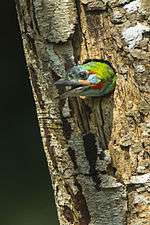Blue-eared barbet
| Blue-eared barbet | |
|---|---|
.jpg) | |
| Blue-eared barbet in Phuket, Thailand | |
| Scientific classification | |
| Kingdom: | Animalia |
| Phylum: | Chordata |
| Class: | Aves |
| Order: | Piciformes |
| Family: | Megalaimidae |
| Genus: | Psilopogon |
| Species: | P. duvaucelii |
| Binomial name | |
| Psilopogon duvaucelii (Lesson, 1830) | |
| Synonyms | |
|
Megalaima duvaucelii | |
The blue-eared barbet (Psilopogon duvaucelii) is an Asian barbet. Barbets are a group of near passerine birds with a worldwide tropical distribution. They get their name from the bristles which fringe their heavy bills.
Description
This small barbet is 17–18 cm (6.7–7.1 in) in length. It is a plump bird, with a short neck, large head and short tail. The bill is dark, and the body plumage is green, but the subspecies have different head patterns. The adult male of the form, M. d. cyanotis, which occurs from northeast India and Bangladesh to peninsular Thailand has a black forehead, blue midcrown, ear coverts and throat, red markings above and below the earcoverts, and orange cheeks. The female has a duller head pattern with a more orange tint to the patches above and below the ear coverts, and the juvenile has a green head with some blue on the ear coverts and throat.
The male’s territorial call is a repeated loud ko-tek. Other calls include a whistled pleow.
Distribution and habitat

The blue-eared barbet is a resident breeder in the hills from northeast India east through Southeast Asia to Singapore, Indonesia and Borneo. It is a species of broadleaf evergreen forest, mixed woodland and second growth up to 1525 m altitude. It nests in a tree hole.
Subspecies are
- P. d. cyanotis, eastern Nepal and northeastern India to southern China and northern Thailand
- P. d. stuarti, western and central Thailand
- P. d. orientalis, southeast Thailand and Indo-China
- P. d. duvaucelii, Malaysia, Sumatra, and the lowlands of Borneo
- P. d. gigantorhinus, Nias Islands, west Sumatra
- P. d. tanamassae, Batu Islands, west Sumatra
Ripley's P. a. eximia, north Borneo, is now usually split as the Bornean barbet, P. eximia.
References
- ↑ BirdLife International (2012). "Psilopogon cyanotis". IUCN Red List of Threatened Species. Version 2013.2. International Union for Conservation of Nature. Retrieved 26 November 2013.
- Birdlife International
- Grimmett, Inskipp and Inskipp, Birds of India ISBN 0-691-04910-6
- Robson, Craig A Field Guide to the Birds of Thailand ISBN 1-84330-921-1
- Ripley, The Barbets, The Auk Vol 62 (1945)
